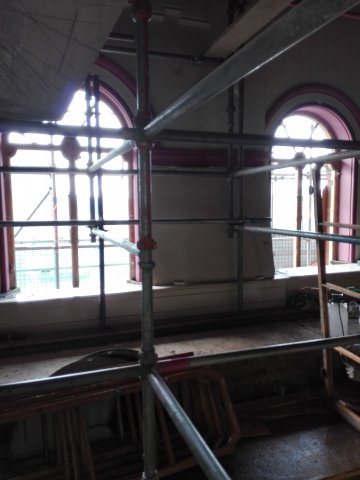Let there be light! Original windows uncovered as part of Tamworth Assembly Rooms refurbishment

Original windows of the main auditorium at Tamworth Assembly Rooms are being uncovered and restored as part of a major project to transform the historic theatre into a modern venue fit for 21st century audiences.
Work to refurbish the building is progressing well with many noticeable changes taking place since principal contractors, Novus Property Solutions, started on site at the end of last year.
A significant phase of the project, to repair the slate roof, has now been completed. This included taking off all the tiles, installing an insulation system, repairing any damaged beams and replacing existing slates where possible.
Workers are now busy repairing external masonry, underpinning the existing foundations and refurbishing the 19 original windows in the main auditorium.
Opening up the large windows was a key aim of the project so that light can be let back into the theatre for the first time in decades. Once uncovered and restored, the windows will be fitted with special adjustable blackout blinds that can be raised and lowered, depending on the event. This means the auditorium will be suitable for a wider variety of day-time events, such as conferences and exhibitions, as well as evening shows and productions.
The windows will also be fitted with secondary glazing to improve the sound and heating insulation in the main hall.
The £3.38m building contract to refurbish, extend and modernise Tamworth Assembly Rooms is part of a £4.8m makeover to preserve and enhance the 128-year-old theatre.
Novus Property Solutions is working as part of a project team made up of architects, engineers, quantity surveyors and a project manager.
Their task includes the creation of a café bar and exhibition space, a new box office, glazed double doors at the front and a brand new glass extension on the side of the building, which will be used as a studio space.
Accessibility will be enhanced with a new access ramp outside and an improved layout throughout and the current tiered seating will be replaced with new state-of-the-art retractable seating to create a contemporary and flexible theatre space. Back stage areas will be improved for performers and the building will be decorated throughout.
Although the theatre is being significantly refurbished and updated, its ornate historic features will be conserved.
Internally, the building is now unrecognisable as features such as the bar, box office, tech box and auditorium seating have all been carefully removed and the dressing rooms block at the back of the building has been completely demolished, ready for the new extension to be built.
Tamworth Borough Council’s Heritage Access Officer, Tom Hobbs, said: “Opening the original windows was something we really wanted to do. They were closed previously for groups performing on stage in the evenings, and we didn’t have the option to open them when needed.
“I’m looking forward to seeing what the original windows look like and it will be amazing to have natural light in the auditorium again. This way we will be able to have the windows open or closed, depending on the event, which will give us much more flexibility in terms of what the venue can be used for. Other than that, the work is progressing well and changes are happening really fast.”
Mark Foxall, contracts manager at Novus Property Solutions, said: “Building work is progressing well on Tamworth Assembly Rooms. The roofing work has been successfully completed utilising the existing slates where possible, along with a small percentage of reclaimed slates to match the remaining ones. The next stage is underpinning the foundations of the historic building prior to commencing construction of the new extension.”
The overall £6.1million scheme includes the creation of Tamworth Enterprise Centre, a new restaurant in the Carnegie Centre and the development of new ‘public realm’ open space.
It is being funded by the Staffordshire and Stoke on Trent LEP’s Single Local Growth Fund (£2.95m), the Heritage Lottery Fund (£903,400), Arts Council England (£365,000) and the remainder from Tamworth Borough Council.
The construction phase is expected to take around 14 months overall and will be followed by further internal and technical work. If all goes to plan, the theatre should reopen during 2019, but further updates will be issued as the project progresses.
Other members of the project team include Brownhill Hayward Brown Architects, who have worked on the designs for the landmark building, Keelagher Okey Klein quantity surveyors, Cundall structural engineers and mechanical and electrical engineers BWB Consulting.
The whole project is being managed by Rider Levett Bucknall UK.







